Nicole, a marketing manager, juggles a team of 10 direct reports. Her days are a mix of project updates, one-on-one meetings, and troubleshooting individual roadblocks. Meanwhile, David, the head of sales, oversees a team of 5 but seems to have a laser focus on individual performance and fosters a culture of ownership.
What’s the difference? It all boils down to the concept of span of control, a critical yet often overlooked element of organizational structure. In this blog post, we tell you everything you need to know about span of control to build a thriving workforce.

What is Span of Control and Why Should You Care?
Span of Control Definition
Span of Control, also known as span of management, is the number of employees a manager directly supervises. It’s your team’s reporting hierarchy – how many people answer directly to a single manager.
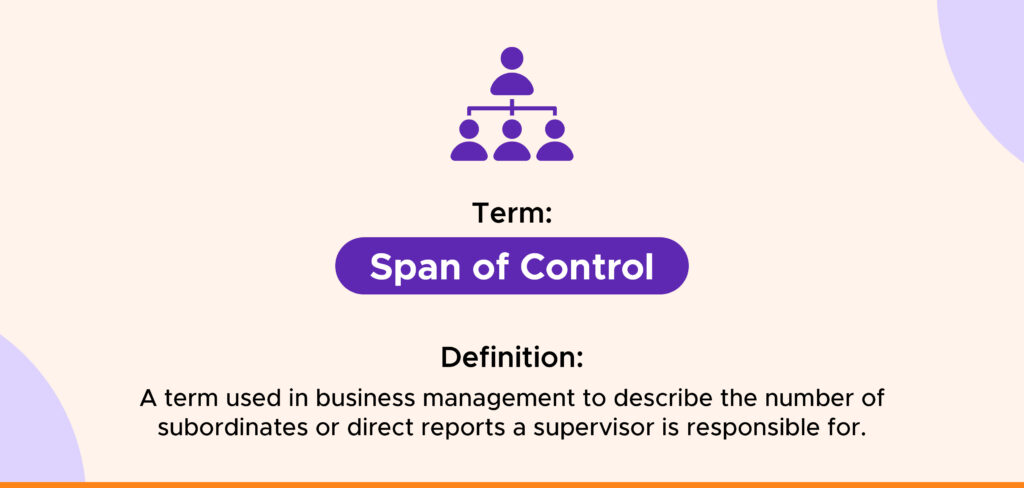
But span of control isn’t just about reporting lines; it significantly impacts your employees’ experience and your organization’s success.
Here’s how:
Managerial Effectiveness: The right span of control allows managers to be effective leaders. If a manager has too many people to oversee, they might struggle to provide proper guidance and support to each team member. On the other hand, with the right number of people, managers can offer more personalized attention, leading to better employee development and performance.
Communication Dynamics: Clear communication is vital for any team. The span of control influences how information flows. With a balanced SOC, communication channels are streamlined, ensuring everyone gets the information they need, when they need it.
Adaptability and Innovation: Think about it – the fewer employees in the layers of management (wider span of control), the faster decisions can be made. This agility is crucial in today’s fast-paced business environment. Flatter structures with wider spans of control can also encourage a more innovative culture as employees have more autonomy and ownership over their work.
Workload and Delegation: It directly affects workload distribution. A manager with a large number of subordinates might struggle to delegate tasks effectively, leading to burnout for both the manager and the team. With a well-defined SOC, managers can delegate tasks appropriately, empowering employees and fostering a sense of ownership.
What is the ideal span of control ratio?
An article by McKinsey recommends not having a one-size-fits-all ideal span of control ratio. Instead, they suggest a more nuanced approach based on the complexity of the manager’s work. They identified five managerial archetypes (or supervisor archetypes):
- Player Archetype (3-5 reports): These managers handle complex and unique tasks that demand extensive experience, such as strategic planning or consulting roles.
- Coach Archetype (6-7 reports): Managers in this category balance individual tasks with supporting their team through established processes. This archetype is often found in roles like marketing analytics management.
- Supervisor Archetype (8-10 reports): Overseeing standardized work with some degree of individual responsibility characterizes this archetype. Examples include accounting managers or senior finance VPs.
- Facilitator Archetype (11-15 reports): Managers in this category handle highly standardized tasks with minimal individual contribution. Typical roles might include accounts payable or receivable managers.
- Coordinator Archetype (15+ reports): This archetype is focused solely on managing routine and automated tasks, often found in roles like call center management.
This framework helps determine the optimal span of control based on the specific skills and experience required for the manager’s team, not an arbitrary number.
How is the span of control ratio calculated?
Calculating your organization’s managerial Span of Control ratio is a straightforward process. Here’s the simple formula:
Span of Control Ratio= Total Number of Employees *in a Specific Department* / Total Number of Managers *in that Department*
Now that we’ve seen how you can calculate the span of control ratio, let’s look at the types of span of control.
Types of Span of Control in Organizational Structure
When it comes to span of control, there are two main approaches: wide spans (flat structures) and narrow spans (tall structures).
Wide Spans (Flat Structures):

Imagine a company with minimal layers of management – that’s a flat structure with a wide span of control.
Advantages of Wide Span of Control
Faster Decision-Making: Fewer layers of management mean information travels quickly, allowing for swifter decisions. Imagine a small startup with a wide span of control. The marketing manager, directly overseeing a team of designers and copywriters, can collaboratively brainstorm and approve campaign ideas quickly, adapting to market changes faster.
Reduced Management Overhead Costs: With fewer managers, there’s a lower cost associated with salaries and benefits. This can be particularly beneficial for smaller businesses or startups with limited resources.
Fostering Autonomy and Ownership: Wider spans empower employees to make decisions and take ownership of their work. A software development team with a wide span of control might allow developers to choose their development tools and methodologies, fostering a sense of ownership and innovation.
Disadvantages of Wide Span of Control
Manager Overload: With a large number of direct reports, managers can become overwhelmed, struggling to provide adequate individual attention and support. This could lead to employee frustration and decreased performance. Imagine a sales manager with a wide span overseeing 15 salespeople. They might struggle to offer personalized coaching and feedback, hindering individual growth.
Limited Coaching and Development: Less manager time translates to fewer opportunities for coaching and development. In a wide-span customer service department, the manager might focus on resolving immediate issues with less time dedicated to teaching new skills or career development plans for individual representatives.
Communication Breakdowns: With a wider span, communication can become more complex. Information might not reach all team members efficiently, leading to confusion and delays. A wide-span engineering team might experience communication silos between different sub-teams working on separate projects.
Narrow Spans (Tall Structures):
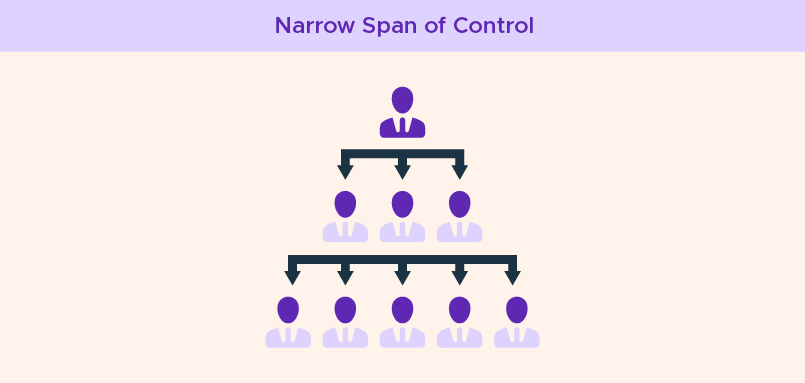
Think of a traditional pyramid-shaped organization with multiple management levels – that’s a tall structure with a narrow span of control.
Advantages of Narrow Span of Control
Closer Supervision and Guidance: Narrow spans allow for closer oversight and personalized guidance from managers. This can be beneficial for new employees or teams working on complex tasks. Imagine a team of junior accountants overseen by a senior accountant in a narrow-span structure. The senior accountant can provide close supervision and guidance, ensuring accuracy and adherence to accounting principles.
Career Development and Mentorship: More managers translate to more opportunities for mentorship and career development. A narrow-span marketing team with dedicated social media and content managers allows for specialized mentorship in each area, helping employees grow their specific skillsets.
Streamlined Communication: Fewer management layers lead to clearer communication channels. Information flows more directly, minimizing confusion and delays. A narrow-span legal department ensures smooth communication between paralegals, associates, and partners, avoiding misinterpretations on important legal matters.
Disadvantages of Narrow Span of Control
Slow Decision-Making: Multiple layers of approval can slow down decision-making. Imagine a large corporation with a narrow-span structure. A marketing campaign idea might require approvals from multiple managers before reaching the final decision-maker, hindering agility.
Higher Management Costs: More managers mean higher overhead costs associated with salaries and benefits. This can be a burden for larger organizations.
Micromanagement: With closer supervision, there’s a risk of micromanagement, where managers control every detail of employee work. This can stifle creativity and employee morale. A narrow-span design team with a micromanaging manager might dictate every design decision, hindering the team’s creative problem-solving abilities.
The ideal span of control depends on your specific needs and context, and other various factors.
What Factors Influence the Ideal Span of Control?
Generally, there are 5 main factors that influence the ideal span of control. This includes managerial capability, employee skill level, task complexity, work environment, and communication and collaboration needs. Let’s have a closer look at these factors.
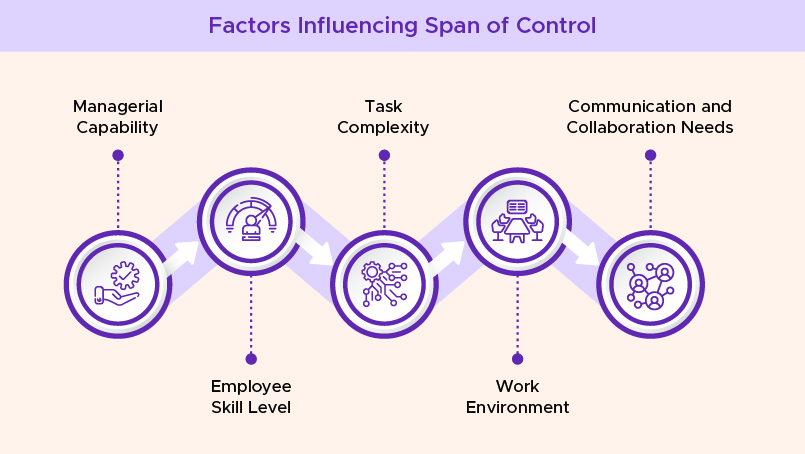
Managerial Capability
Experienced managers with strong leadership and delegation skills can effectively handle a wider span of control. They can provide adequate guidance to a larger team and empower them to make decisions.
On the other hand, less experienced managers might benefit from a narrow span of management, allowing them to focus on individual coaching and development for their direct reports.
Employee Skill Level
Highly skilled and experienced employees require less supervision. They can work independently, solve problems effectively, and manage their own workloads. This allows for a wider SOC, fostering a sense of ownership and autonomy within the team.
Conversely, teams with less experience or those tackling new, complex tasks might need a narrower SOC. This ensures closer supervision and readily available support from managers.
Task Complexity
The complexity of the work directly impacts the ideal SOC. Complex tasks with a high knowledge requirement necessitate closer oversight. A narrower span of control allows managers to provide more in-depth guidance, ensure quality control, and identify potential roadblocks early on.
Conversely, routine or well-defined tasks can be effectively managed with a wider SOC, as employees can handle them independently with minimal supervision.
Work Environment
Consider the overall work environment. Unpredictable or fast-paced environments, such as startups or emergency response teams, benefit from a narrower SOC. This fosters quicker decision-making and allows for more agile responses to changing situations.
In contrast, stable environments with well-defined processes might function well with a wider SOC, as there’s less need for immediate managerial intervention.
Communication and Collaboration Needs
Frequent collaboration often necessitates a narrower SOC. With a smaller team size, communication becomes more streamlined, and information flows more effectively. This is crucial for ensuring everyone is on the same page and can work together seamlessly.
Conversely, teams with less frequent collaboration needs might function well with a wider SOC, as communication can still be managed effectively through regular meetings and digital tools.
By understanding these factors and analyzing your specific workforce, you can determine the optimal span of control for each team within your organization.
Remember, the ideal structure is not a one-size-fits-all approach. A strategic balance between empowerment and oversight is key to fostering a thriving and successful workforce.
Optimizing Span of Control for Your Organization
Now that you understand the factors influencing your ideal Span of Control, it’s time to translate that knowledge into action.
Here’s a clear roadmap to optimize span of control for your organization:
Step 1: Conduct a Span of Control Analysis
The first step is to gain a clear picture of your current span of control situation. This involves:
Mapping Your Structure: Visually map your entire organizational structure, including all departments, teams, and individual roles. This can be done using software tools or a simple whiteboard exercise.
People analytics tools like Peoplebox let you easily visualize the organizational structure by drilling down into individual profiles based on over 50 key metrics.
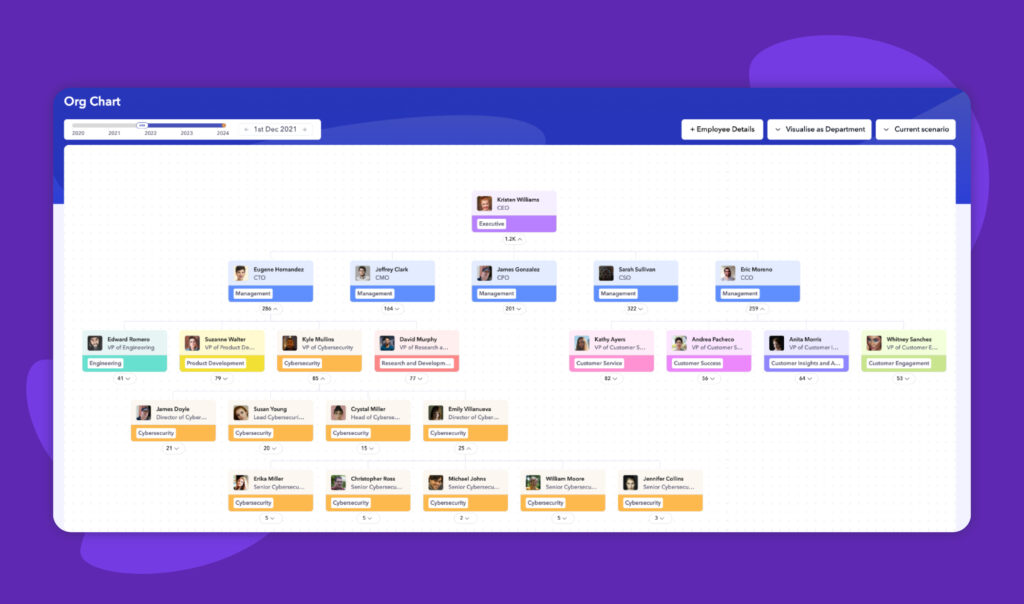
Workload Assessment: Go beyond numbers and assess the actual workload each team and manager handles. Consider factors like project complexity, meeting schedules, and individual responsibilities. Utilize surveys or one-on-one discussions to gather insights directly from employees and managers.
Calculating span of control Ratios: Don’t settle for a single company-wide span of control ratio. Calculate the span of control ratio for each department or team individually using the formula shared at the beginning of this article, or you can see the image below.
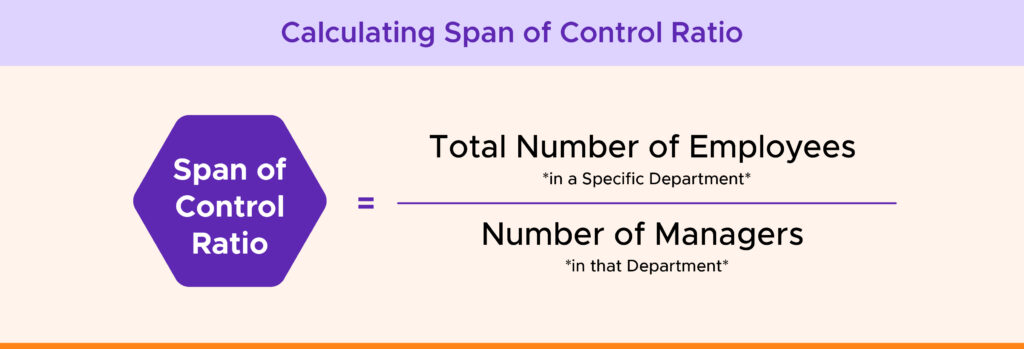
Step 2: Evaluate the Effectiveness
Numbers tell part of the story, but the real impact lies in how the span of control is affecting your workforce. Here’s how to assess effectiveness:
Employee Engagement Surveys: Gauge employee sentiment through surveys. Ask targeted questions about job satisfaction, workload, supervision, and decision-making speed. Are employees feeling empowered and supported, or overwhelmed and frustrated?
Analyze responses to identify trends related to SOC. For example, high workload complaints might suggest a team with a manager overseeing too many direct reports.
Performance Reviews: Analyze trends in team productivity, quality of work, and individual performance. Look for correlations between span of control and performance. Are teams with a narrower span of control consistently exceeding expectations, or is there a lack of clear direction and guidance?

Communication Audits: Evaluate how information flows within teams and across departments. Are there communication silos hindering collaboration, or is information readily available to everyone who needs it?
Step 3: Restructure When Necessary
Based on your analysis, it might be time to adjust your structure:
Redistributing Direct Reports: If managers are overloaded, consider redistributing direct reports among teams to achieve a more balanced workload. This might involve shifting responsibilities or creating cross-functional teams.
Creating New Management Positions: For teams with highly complex tasks or less experienced employees, creating new management positions might be necessary to provide adequate support. This allows for closer supervision and more focused attention on individual development.
Step 4: Invest in Management Development
Equipping your managers with the skills to handle their span of control effectively is crucial for long-term success. Here’s how:
Delegation Training: Provide managers with practical training on effective delegation techniques. This includes identifying tasks that can be delegated, matching tasks to employee skillsets, and setting clear expectations for deliverables.
Communication Skills Workshops: Equip managers with the communication skills they need to keep their teams informed, engaged, and aligned with goals. This includes active listening, providing constructive feedback, and fostering open communication channels.
Leadership Development Programs: Invest in leadership development programs that hone managers’ ability to motivate, inspire, and guide their teams. This can cover topics like conflict resolution, leadership styles, performance management, and building high-performing teams.
Throughout this process, technology can be your greatest ally. Utilizing tools like HRIS, engagement surveys, and performance management systems enables data-driven decision-making and cultivates an environment of transparent communication.
Building a Thriving Workforce with Peoplebox
Peoplebox, the most-integrated OKR, performance management, and people analytics software, empowers strategic workforce decisions through its intuitive platform. Peoplebox seamlessly integrates with your existing Human Resources systems, keeping your data up-to-date and enabling effortless goal-setting and performance management. Build effective workforce plans with scenario modelling, and leverage real-time employee insights to optimize your Span of Control.
Ready to build a high-performing organization? Contact us today to see how we can help!









